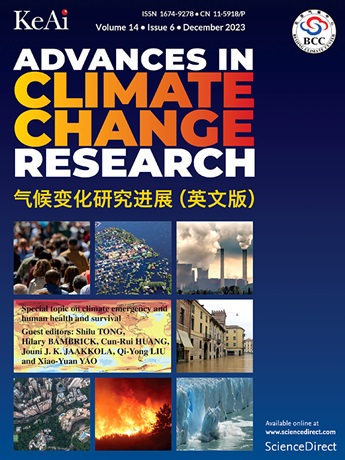High-altitude precipitation controls the mass balance of Pasu Glacier, Karakoram over 2000–2020: A case study based on mass and energy budget
IF 5.2
1区 地球科学
Q1 ENVIRONMENTAL SCIENCES
引用次数: 0
Abstract
Glaciers in the Karakoram exhibit stability or near-balanced mass changes, in stark contrast to the widespread glacier retreat observed globally. However, the limited availability of observational data, coupled with the lack of in-depth exploration of ablation physical mechanisms, has hindered a comprehensive understanding of the factors driving the anomalous behavior of these glaciers. This study employs an energy‒mass balance model, validated against observational data, and focuses on the representative Pasu Glacier to identify the key factors contributing to the near-balanced glacier mass budget observed over 2000–2020. The analysis revealed an average mass balance of −0.030 ± 0.247 m w.e. per year for Pasu Glacier in 2000–2020, with an average equilibrium line altitude of 4150 m. While snowfall was the primary determinant of mass balance for interannual and seasonal variations, turbulent heat exchange also played a significant role in the glacier's energy balance process. Through an analysis of altitude gradients and long-term variations in mass‒energy gain and loss and comparisons with other glaciers in High Mountain Asia (HMA), we concluded that 1) the balanced state of Pasu Glacier was largely attributed to the magnitude and extent of the accumulation of precipitation at high elevations, 2) reduced snowfall in highly accumulated areas (−0.79% per year), increasing melting intensity (0.026 m w.e. per year), and prolonged melting duration (∼24 d during 2000–2020) indicated a negative tendency of glacier mass budgets, and 3) Pasu Glacier exhibited similar characteristics of continental glaciers in terms of energy balance and polar continental glaciers in terms of mass gain, which have contributed to the stability of Pasu Glacier in 2000–2020. Our findings provide valuable insight into the dominant factors contributing to the balanced state of Pasu Glacier and can be applied to addressing other glacier changes in the Karakoram.
高原降水控制2000-2020年喀喇昆仑帕苏冰川物质平衡:基于质量和能量收支的案例研究
喀喇昆仑的冰川表现出稳定或接近平衡的质量变化,与全球广泛观察到的冰川退缩形成鲜明对比。然而,由于观测数据的有限,加上缺乏对消融物理机制的深入探索,阻碍了对驱动这些冰川异常行为的因素的全面理解。本研究采用能量-质量平衡模型,并对观测数据进行验证,以代表性的帕苏冰川为研究对象,确定2000-2020年观测到的冰川质量收支接近平衡的关键因素。结果表明,2000-2020年帕苏冰川的平均质量平衡为- 0.030±0.247 m w.e.e. /年,平均平衡线高度为4150 m。虽然降雪是年际和季节变化的物质平衡的主要决定因素,但湍流热交换在冰川能量平衡过程中也起着重要作用。通过对海拔梯度和质能损益长期变化的分析,并与亚洲高山冰川(HMA)的其他冰川进行比较,我们得出结论:1)帕苏冰川的平衡状态主要归因于高海拔地区降水积累的幅度和程度;2)高积雪区降雪量减少(- 0.79% /年),融化强度增加(0.026 m w.e. /年);2000-2020年融化持续时间延长(~ 24 d)表明冰川质量收支呈负趋势。3)帕苏冰川在能量平衡方面与大陆冰川和极地大陆冰川在质量增加方面表现出相似的特征,这有助于帕苏冰川在2000-2020年的稳定性。我们的发现为了解帕苏冰川平衡状态的主导因素提供了有价值的见解,并可应用于解决喀喇昆仑其他冰川变化的问题。
本文章由计算机程序翻译,如有差异,请以英文原文为准。
求助全文
约1分钟内获得全文
求助全文
来源期刊

Advances in Climate Change Research
Earth and Planetary Sciences-Atmospheric Science
CiteScore
9.80
自引率
4.10%
发文量
424
审稿时长
107 days
期刊介绍:
Advances in Climate Change Research publishes scientific research and analyses on climate change and the interactions of climate change with society. This journal encompasses basic science and economic, social, and policy research, including studies on mitigation and adaptation to climate change.
Advances in Climate Change Research attempts to promote research in climate change and provide an impetus for the application of research achievements in numerous aspects, such as socioeconomic sustainable development, responses to the adaptation and mitigation of climate change, diplomatic negotiations of climate and environment policies, and the protection and exploitation of natural resources.
 求助内容:
求助内容: 应助结果提醒方式:
应助结果提醒方式:


